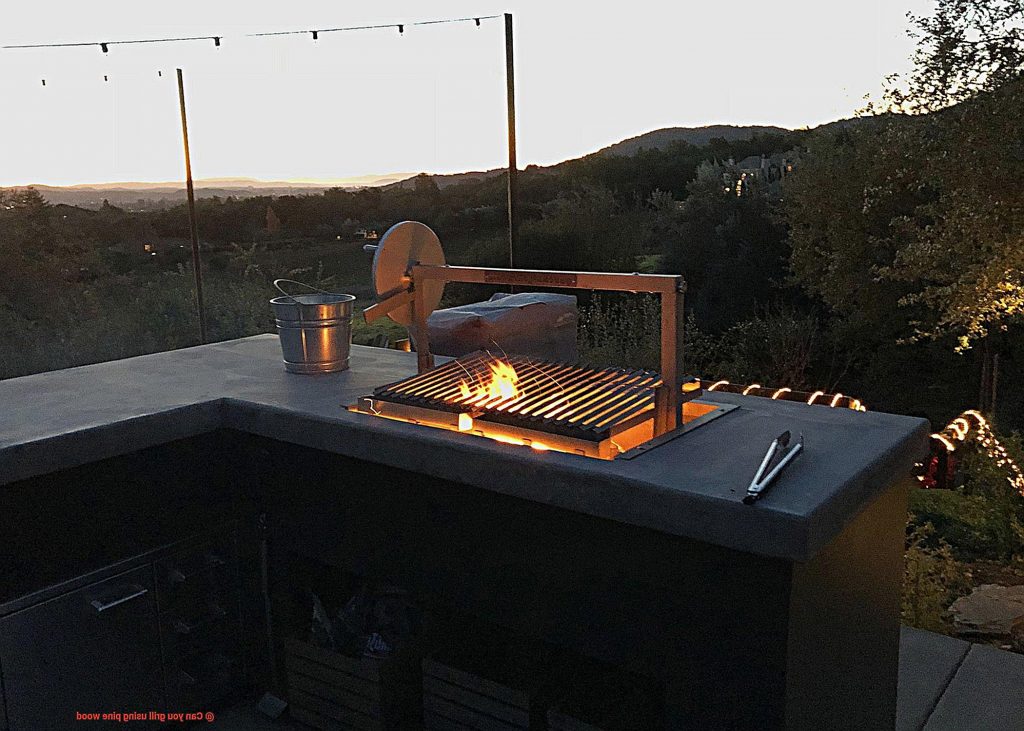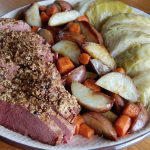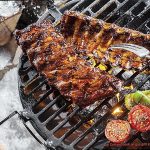It’s summertime, and nothing screams “grilling season” like the smell of sizzling meat and veggies on the BBQ. As a seasoned griller, you know that the type of wood you use can make or break the flavor of your food. But what about pine wood? Can you use it for grilling, or is it a recipe for disaster?
Pine wood is abundant and often used for smoking meat in some regions worldwide. However, opinions on using pine wood for grilling vary widely, making it challenging to determine if it’s safe or not. The truth is that whether or not pine wood is suitable for grilling depends on several factors.
In this article, we’ll explore the world of pine wood and grilling, examining its safety, differences from other woods like oak and fruitwoods, and how it affects your grilled food’s flavor. We’ll also look at different types of pine wood available for grilling and offer tips on how to use them safely. So without further ado, let’s dive into whether or not you should say yay or nay to using pine wood for your next BBQ.
Contents
What is Pine Wood?
Pine wood is a versatile softwood that comes from pine trees found in North America, Europe, and Asia. Its light color and straight grain pattern make it a popular choice for construction and furniture-making. Pine wood is also commonly used as a fuel source for fires and grilling, but there are some things to keep in mind when using it for these purposes.
One of the main concerns with using pine wood for grilling is its high resin content. Resin is a sticky substance produced by pine trees as a defense mechanism against insects and disease. When burned, resin can produce thick smoke and cause a buildup of creosote in the chimney or grill. This can lead to potential fire hazards if not properly cleaned out.
Despite these risks, many people still choose to grill with pine wood because of its affordability and availability. To minimize the potential dangers associated with using this type of wood, it’s essential to use well-seasoned wood that has been dried out for at least six months to reduce the amount of resin present. It’s also best to avoid using green or freshly cut pine wood, which tends to have higher levels of resin.
When it comes to construction and furniture-making, pine wood is a popular choice due to its affordability and aesthetic appeal. However, it’s important to note that pine wood is not as strong or durable as other types of hardwoods like oak or maple. This means that it may not be the best choice for certain applications where strength and durability are required.
Another thing to keep in mind when using pine wood for any purpose is its tendency to spark and pop when burned. This can be dangerous when grilling and can also affect the taste and quality of the food being cooked.
Is Pine Wood Safe to Use for Grilling?
Let me share my expert knowledge on this topic.
One of the main concerns with using pine wood for grilling is its high levels of resin and sap. Not only can this cause flare-ups, but it can also leave a bitter taste in your food. On top of that, burning pine wood releases harmful chemicals like benzene and formaldehyde that can be dangerous if inhaled.
But don’t give up on pine wood just yet. Some varieties, such as Ponderosa pine, have lower levels of resin and sap than others. And if you ensure that the wood is properly seasoned and dried before use, you can reduce the amount of sap and resin even further.
However, it’s essential to consider the source of the pine wood. If it has been treated with chemicals or pesticides, then it’s not safe for grilling as these substances can be harmful when ingested.
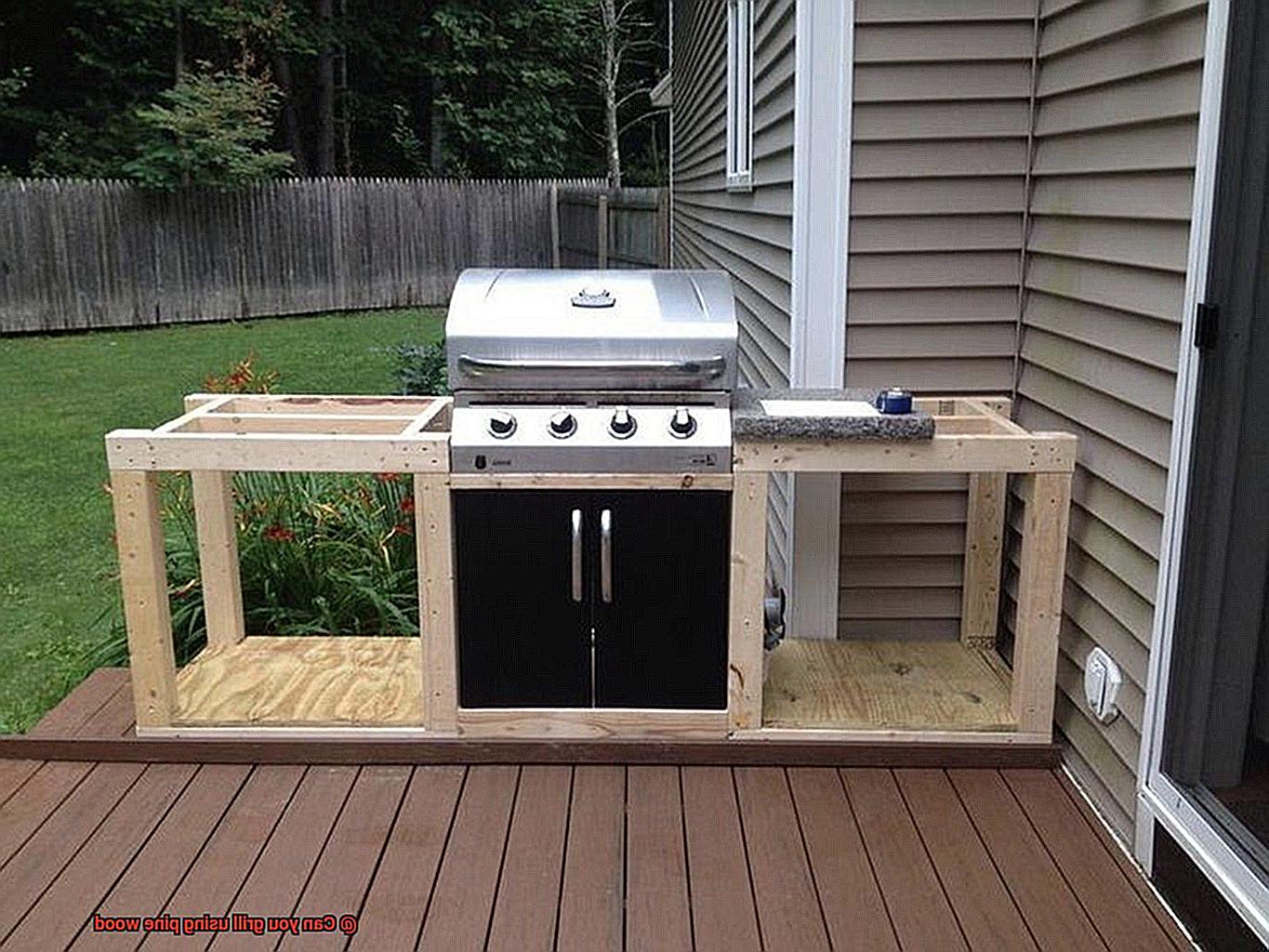
Pros and Cons of Using Pine Wood for Grilling
Grilling is not just about cooking food; it’s an experience that involves the senses. The type of wood used can significantly impact the flavor and aroma of the food. Pine wood is a popular choice for many grillers due to its availability and affordability. However, before you decide to use pine wood for grilling, it’s essential to consider its pros and cons.
Let’s begin with the pros. Pine wood is easily accessible at most hardware stores and supermarkets, making it a convenient option for grillers who need wood for their BBQ. Moreover, it’s relatively inexpensive, making it an affordable option for budget-conscious grillers. Pine wood also has a mild flavor that pairs well with a wide range of meats and vegetables, imparting a slightly sweet and smoky taste to your food without overpowering it.
However, pine wood has some cons that you need to be aware of. First, pine wood contains high levels of resin, which can cause flare-ups and uneven cooking. Additionally, if not burned correctly, it can leave a bitter taste in your food. Second, pine wood produces thick and acrid smoke that can be overwhelming and unpleasant if overused. Lastly, most pine wood used for grilling comes from unsustainable sources, leading to deforestation and habitat destruction.
So, should you use pine wood for grilling? It depends on what you’re looking for. If you want a mild-flavored BBQ at an affordable price, pine wood might be an excellent choice for you. However, suppose environmental impact or consistent grilling experience is your concern. In that case, you should consider alternative options such as fruitwood or hardwood.
How to Properly Season and Dry Pine Wood for Grilling
Grilling with pine wood can be a fantastic way to add a distinct smoky flavor to your favorite dishes. However, not properly seasoning and drying the wood can result in excessive smoke and an unpleasant taste. In this guide, we’ll take a closer look at how to properly season and dry pine wood for grilling, so you can enjoy delicious and flavorful meals every time.
Choosing the Right Pine Wood
The first step in preparing pine wood for grilling is selecting the right type of wood. Softwood varieties such as white pine or spruce are ideal as they are easier to cut and split. Avoid using pressure-treated or chemically treated pine wood as it may emit harmful chemicals when burned.
Seasoning and Drying Pine Wood
The next step is to properly season and dry the wood. This process requires allowing the wood to dry out completely over several months. You should stack the wood in a dry, well-ventilated area and cover it with a tarp or other protective covering to ensure it remains dry. It’s important to note that freshly cut pine wood contains a lot of moisture, which can cause excessive smoke and flare-ups when used for grilling.
You’ll know your wood is properly seasoned and dried when it has a moisture content of around 20%. You can use a moisture meter to test the wood and ensure it’s ready for grilling. Alternatively, you can use a kiln or oven to dry out the wood faster by heating it at low temperatures for several hours.
Using Pine Wood for Grilling
Once your pine wood is properly seasoned, dried, and ready for use, it’s important to keep in mind that it’s best used for certain types of food. Pine wood pairs well with poultry or seafood but may not be suitable for red meat or other heavy meats as the smoke can overpower the flavor of the meat.
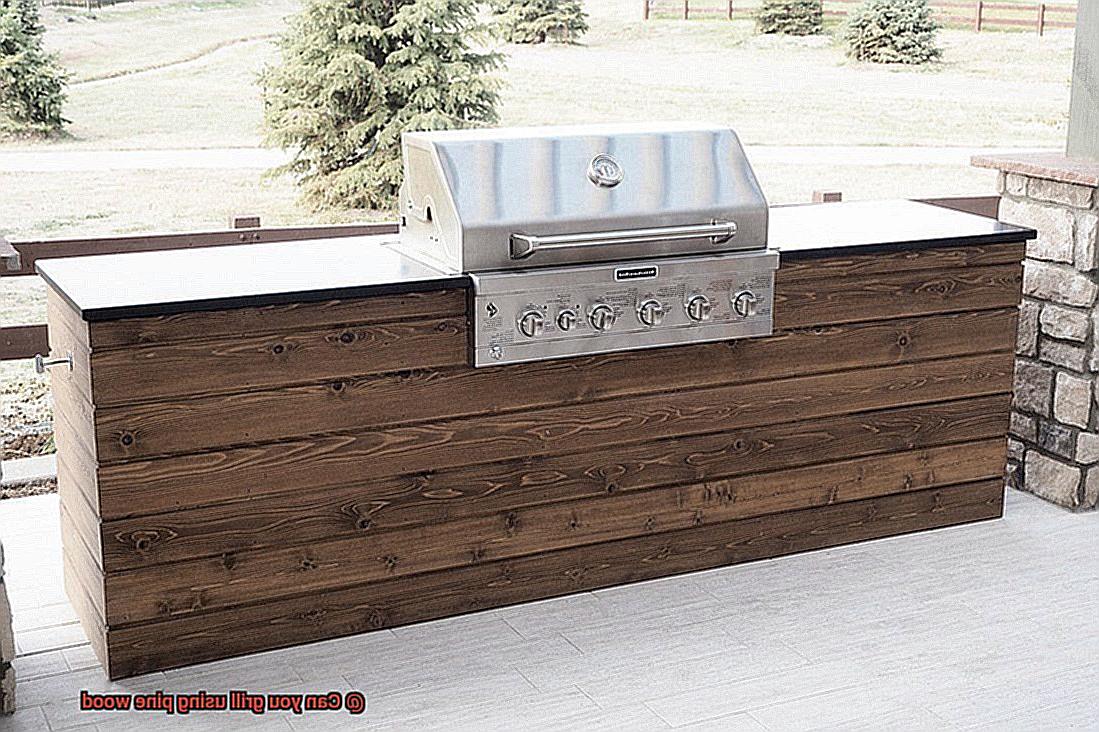
Other Types of Hardwoods Suitable for Grilling and Smoking
If you’re looking to take your grilling and smoking game to the next level, it’s essential to choose the right type of hardwood. While pine wood may seem like an easy option, its high resin content and potential safety hazards make it unsuitable for grilling or smoking. Luckily, there are plenty of other hardwoods that offer unique flavors and characteristics to enhance your cooking.
Oak is a popular choice for grilling and smoking due to its mild, smoky flavor that complements a variety of meats and vegetables. It burns evenly and produces a steady heat, making it a reliable choice for any grilling or smoking project. Oak wood is also versatile, working well with almost any type of meat.
Hickory is another commonly used hardwood with a strong, bold flavor that works well with pork, beef, and poultry. However, it can be overpowering if used in excess, so it’s best to use it sparingly or in combination with milder woods like oak. Hickory wood burns slowly and evenly, producing a consistent heat that helps lock in moisture and flavor.
For those who prefer a milder wood flavor, fruitwoods like apple, cherry, and peach are excellent options. These woods have a sweet, fruity flavor that works well with pork, poultry, and fish. They burn quickly and produce a mild heat, making them ideal for shorter cooking times or when you want to add a subtle flavor to your food.
Mesquite wood is another popular choice for grilling and smoking, particularly in southwestern cuisine. It has an intense flavor that pairs well with beef, lamb, and game meats. However, it can also be overpowering if used too heavily, so it’s best to mix it with milder woods like oak or apple. Mesquite wood burns hot and fast, making it suitable for quick sears or low and slow brisket cooks.

Other hardwoods suitable for grilling and smoking include maple and pecan. Maple wood adds a delicate sweetness that complements ham and bacon, while pecan has a slightly nutty flavor that pairs well with pork and lamb. When selecting your wood for grilling or smoking, consider the type of meat being cooked and your personal preference for flavor intensity.
The Impact of Resin Content on the Taste and Quality of Food Being Cooked
When it comes to grilling and smoking meats, choosing the right type of wood is critical for achieving the perfect taste and texture. Pine wood, in particular, has some unique qualities that can impact your culinary creations. One significant factor to consider when using pine wood is its resin content, which can have a strong flavor and aroma. While some people enjoy this unique taste, others may find it overpowering or unpleasant. Additionally, the resin can cause the wood to burn quickly and produce a lot of smoke.
So how does this impact the taste and quality of your food? The resin can leave a sticky residue on your grill grates or make your food have an undesirable texture. Moreover, the strong flavor and excessive smoke can overwhelm the natural flavors of your meat, leaving an unpleasant taste.
To minimize these effects, it’s best to use aged or seasoned pine wood. This process allows some of the resin to evaporate, resulting in a milder flavor and slower burning wood. It’s also crucial to avoid using green or freshly cut pine wood since they tend to have the highest resin content.
Here are some sub-topics that can help you understand better:
- The unique flavor of pine wood: Pine wood’s high resin content gives it a distinctive flavor that can enhance the taste of grilled food.
- The downsides of using pine wood: The strong flavor, excessive smoke, and sticky residue can negatively affect the quality of your food.
- Aged or seasoned pine wood: Using aged or seasoned pine wood can help minimize the impact of resin on your food’s taste and quality.
- Avoiding green or freshly cut pine wood: Green or freshly cut pine wood has the highest resin content, producing excessive smoke that overwhelms the natural flavors of your meat.
Potential Fire Hazards When Burning Pine Wood
If pine wood is your go-to choice, it’s important to be aware of the potential fire hazards that come with it. As an expert on this topic, I have compiled research notes to help you enjoy grilling with pine wood while staying safe.
One of the biggest concerns with using pine wood for grilling is the risk of sparks and embers. Pine wood contains resin, which is highly flammable and can quickly ignite, leading to a dangerous situation. As the resin heats up and expands, it can burst out of the wood in the form of sparks that can easily catch fire on nearby materials, such as dry leaves or grass.
Another potential hazard when grilling with pine wood is the buildup of creosote. This black or brown tar-like substance can accumulate inside chimneys and flues when organic materials like wood are burned at high temperatures. Pine wood contains more resin than other types of wood, which can increase the production of creosote. If not cleaned regularly, this buildup can increase the risk of a chimney fire.
To minimize these risks, follow these precautions:
- Use seasoned pine wood that has been dried for at least six months. This reduces the amount of resin in the wood and makes it less likely to produce sparks and embers.
- Avoid using too much pine wood at once. Instead, mix it with other types of hardwood like oak or maple that have a lower resin content. This balances out the resin content and reduces the risk of sparks and embers.
- Clean your grill regularly to prevent the buildup of creosote. This includes cleaning out ash and debris from the bottom of the grill and scrubbing grates with a wire brush.
Tips on How to Minimize Smoke Inhalation When Grilling with Pine Wood
Grilling with pine wood is a great way to add a smoky flavor to your food, but it can also produce thick smoke that can be harmful to your health if inhaled excessively. To help you minimize smoke inhalation and grill safely with pine wood, we have compiled some tips for you.
Firstly, it is essential to use dry wood. Wet or green pine wood contains high levels of resin, which can produce more smoke and be more challenging to control. Therefore, make sure your pine wood is appropriately dried before using it for grilling. You can check if the wood is dry by tapping two pieces together.
Secondly, don’t use too much wood at once. Using too much wood can create excessive smoke and increase the risk of inhaling too much. Start with a small amount of wood and add more gradually as needed to control the amount of smoke produced.
Thirdly, use a well-ventilated area to help disperse the smoke and reduce its concentration. If possible, grill in an open area outdoors where there is plenty of fresh air. The smoke will be less concentrated and less likely to cause respiratory irritation.
Fourthly, use a windbreak to prevent the smoke from blowing directly into your face or towards your neighbors’ homes. A simple barrier made from plywood or other materials can effectively block the wind and prevent the spread of smoke.
Lastly, avoid standing over the grill and try to stand at a safe distance while using tongs or a spatula to flip and move the food around. Standing directly over the grill increases your exposure to the smoke, and this can be harmful to your health.
15Gs-RG6vVI” >
Also Read: Can You Use Firewood In a Charcoal Grill?
Conclusion
In conclusion, while pine wood can be used for grilling, it’s important to approach it with caution and proper preparation. With its abundance and affordability, many grillers turn to pine wood as a go-to option. However, the high resin content in pine can lead to flare-ups and an unwelcome bitterness in your food if not seasoned and dried correctly. Additionally, burning pine wood releases harmful chemicals that can pose a risk if inhaled.
To minimize potential hazards associated with using pine wood for grilling, it’s crucial to use well-seasoned wood that has been dried out for at least six months. This reduces the amount of resin present and decreases the likelihood of any flare-ups or bitter tastes. It’s also best to steer clear of green or freshly cut pine wood, which tends to have higher levels of resin.
If you do decide to use pine wood for grilling, it’s essential to weigh its pros and cons carefully. While the mild flavor pairs well with a variety of meats and vegetables, overusing it can result in unpleasant smoke and flare-ups.
Ultimately, there are other hardwoods like oak or fruitwoods that offer unique flavors without the potential hazards of using pine wood.

